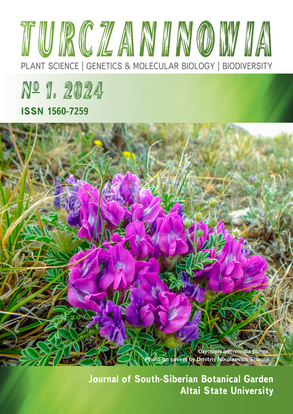New to Russia records of lichens and a lichenicolous fungus from the Kolguev Island (Russian Arctic)
UDC 582.291:581.95(470.111.7)
Abstract
Two species of lichens, Buellia insularis and Polyblastia cataractae, as well as a lichenicolous fungus Lasiosphaeriopsis lecanorae, were identified as new for Russia during the comprehensive studies of vegetation on the Kolguev Island. For each species, a brief description is given based on the specimens studied, differences from closely related species, ecological features, and global distribution are shown.
Downloads
Metrics
References
Богдановская-Гиэнеф И. Д. Природные условия и оленьи пастбища острова Колгуева // Труды НИИ Полярного земледелия, животноводства и промыслового хозяйства. Серия оленеводство, 1938. Вып. 2. С. 7–162.
Diederich P., Lawrey D., Ertz D. 2018. The 2018 classification and checklist of lichenicolous fungi, with 2000 nonlichenized, obligately lichenicolous taxa. The Bryologist 121(3): 340–425. DOI: 10.1639/0007-2745-121.3.340
Foucard T., Moberg R., Nordin A. 2002. Buellia. In: Nordic Lichen Flora Vol. 2. Physciaceae. Uddevalla: TH-tryck AB. Pp. 11–25.
Hafellner J. 2004. Dactylospora. In: Lichen Flora of the Greater Sonoran Desert Region. Volume II (most of the micro lichens, balance of the macrolichens, and the lichenicolous fungi). Tempe: Arizona State University. Pp. 645 648.
Холод С. С., Уваров С. А. Растительные сообщества центральной части острова Колгуев // Отечественная геоботаника: основные вехи и перспективы: Материалы Всерос. конф. (г. Санкт-Петербург, 20–24 сентября 2011 г.). СПб.: ООО «Бостон-спектр», 2011. С. 285–289.
Лавриненко И. А. Типология территориальных единиц растительности для целей крупномасштабного картографирования (на примере острова Колгуев) // Геоботаническое картографирование, 2015. С. 95–119. DOI: 10.31111/geobotmap/2015.94
Лавриненко О. В., Лавриненко И. А. Растительный покров оленьих пастбищ острова Колгуев: преемственность исследований и современные подходы // Ботаника: История, теория, практика: Труды междунар. науч. конф., посвящ. к 300-летию основания БИН РАН (г. Санкт-Петербург, 24–25 июня 2014 г.). СПб.: Изд-во СПбГЭТУ «ЛЭТИ», 2014. С. 124–131.
Магнуссон А. Г. Новые лишайники севера СССР // Известия Главного Ботанического сада СССР, 1927. Т. 26. С. 359–370.
Øvstedal D. O., Tønsberg T., Elvebakk A. 2009. The lichen flora of Svalbard. Sommerfeltia 33: 1−393. DOI: 10.2478/v10208-011-0013-5
Pérez-Ortega S., Halici M. G. 2008. Lasiosphaeriopsis lecanorae sp. nov. (Ascomycota, Nitschkiaceae) on Lecanora polytropa from Spain with a key to the known species of the genus. Mycotaxon 104: 247–251.
Savić S., Tibell L. 2011. Polyblastia in Northern Europe and the adjacent Arctic. Acta Univ. Upsal., Symb. Bot. Upsal. 36(1): 1–69.
Савич В. П. Лишайники, собранные Р. Р. Поле на крайнем севере Европейской России // Труды императорского ботанического сада, 1912. Т. 32. С. 15–67.
Schiefelbein U., Brackel W. v., Cezanne R., Czarnota P., Eckstein J., Eichler M., Kison H.-U., Ungethüm K., Stordeur R. 2017. Trimmatostroma arctoparmeliae sp. nov. and noteworthy records of lichenized, lichenicolous and allied fungi from the Harz Mountains and surrounding regions. Herzogia 30: 80–102. DOI: 10.13158/heia.30.1.2017.80
Смирнова З. Н. Растительные ассоциации о-ва Колгуева // Бот. журн., 1938. Т. 23, № 5–6. С. 413–462).
Smith C. W., Aptroot A., Coppins B. J., Fletcher A., Gilbert O. L., James P. W., Wolseley P. A. (eds.). 2009. The Lichens of Great Britain and Ireland. London: The British Lichen Society. 1046 pp.
Spribille T., Fryday A. M., Hampton-Miller C. J., Ahti T., Dillman K., Thor G., Tønsberg T., Schirokauer D. 2023. Compendium of the lichens and associated fungi of Alaska. Biblioth. Lichenol. 112: 1–522. DOI: 10.1127/bibl_lich/2023/112
Степанчикова И. С., Гагарина Л. В. Глава 8. Сбор, определение и хранение лихенологических коллекций // Флора лишайников России. Биология, экология, разнообразие, распространение и методы изучения лишайников. М.; СПб.: Тов-во науч. изд. КМК, 2014. С. 204–219.
Triebel D. 1989. Lecideicole Ascomyceten. Eine Revision der obligat lichenicolen Ascomyceten auf lecideoiden Flechten. Biblioth. Lichenol. 35: 1–278.
Уваров С. А., Лапина А. М., Лавриненко О. В. Фитомасса лишайников и зеленых растений в сообществах восточноевропейских тундр // Растительные ресурсы, 2021. Т. 57, вып. 1. С. 15–38. DOI: 10.31857/S0033994621010118
Westberg M., Moberg R., Myrdal M., Nordin A., Ekman S. 2021. Santesson’s checklist of Fennoscandian lichen-forming and lichenicolous fungi. Uppsala: Uppsala University, Museum of Evolution. 933 pp.
Zhurbenko M. P., Brackel W. V. 2013. Checklist of lichenicolous fungi and lichenicolous lichens of Svalbard, including new species, new records and revisions. Herzogia 26: 323–359. DOI: 10.13158/heia.26.2.2013.323
Turczaninowia is a golden publisher, as we allow self-archiving, but most importantly we are fully transparent about your rights.
Authors may present and discuss their findings ahead of publication: at biological or scientific conferences, on preprint servers, in public databases, and in blogs, wikis, tweets, and other informal communication channels.
Turczaninowia allows authors to deposit manuscripts (currently under review or those for intended submission to Turczaninowia) in non-commercial, pre-print servers such as ArXiv.
Authors who publish with this journal agree to the following terms:
- Authors retain copyright and grant the journal right of first publication with the work simultaneously licensed under a Creative Commons Attribution License that allows others to share the work with an acknowledgement of the work's authorship and initial publication in this journal.
- Authors are able to enter into separate, additional contractual arrangements for the non-exclusive distribution of the journal's published version of the work (e.g., post it to an institutional repository or publish it in a book), with an acknowledgement of its initial publication in this journal.
- Authors are permitted and encouraged to post their work online (e.g., in institutional repositories or on their website) prior to and during the submission process, as it can lead to productive exchanges, as well as earlier and greater citation of published work (See The Effect of Open Access).





